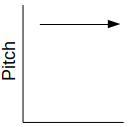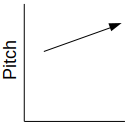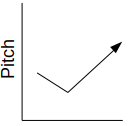In this lesson you will learn som pronunciation basics as well as how to introduce yourself in Chinese.
Table of Contents
An introduction to Chinese tones
Before we dive into this lesson we need to introduce Chinese tones, something we deliberately left out in the previous lesson. Every character in Chinese has one of four tones. A “tone” just refers to the way you pronounce a character. The five Chinese tones are:
- High Tone
- Rising Tone,
- Inflected Tone
- Falling Tone
These are often referred to as the 1st, 2nd, 3rd and 4th tone.
The Chinese tones are shown in the table below. To demonstrate these tones click on the sample character below the tone diagram in the table. Note that the sample character is the “ma” sound, but tones apply equally to all characters and sounds in Chinese.
| First Tone | Second Tone | Third Tone | Fourth Tone |
|---|---|---|---|
| High tone | Rising tone | Inflected tone | Falling tone |
 |
 |
 |
 |
| e.g. 妈 | e.g. 麻 | e.g. 马 | e.g. 骂 |
| Use a steady high pitch when pronouncing the word | Raise your pitch as you pronounce the word | Initially drop your pitch and then raise it as you pronounce the word | Drop your pitch as you pronounce the word |
As you can see the Pinyin uses one of four tone marks above the Pinyin to show the pitch, in the table above we use “ma” to demonstrate the four tones:
- High Tone is uses a horizontal tone mark: e.g. mā
- Rising Tone uses a rising tone mark above the character e.g. má
- Inflected Tone uses a falling and then rising tone mark e.g. mǎ
- Falling tone uses a falling tone mark e,g, mà
Here are some examples of single character words using different tones
- “mother” 妈 – 1st tone (high tone)
- “who” 谁 – 2nd tone (rising tone)
- “you” 你 – 3rd tone (inflected tone)
- “father” 爸 – 4th tone (falling tone)
Most Chinese words are made up of multiple characters, with each character having one of four tones. For example:
- “America” 美国 is made up of two characters, the first is 美 which uses a 3rd tone (the inflected tone). and 国 has a 2nd tone (a rising tone)
- “goodbye” 再见 is made up of two characters, 再 and 见, both have the 4th tone (the falling tone)
Some characters don’t carry a tone, this is known as the 5th or neutral tone, A neutral tone is really just the absence of a tone rather than a real tone. As a rule of thumb the neutral tone is lower in pitch than the previous tone, unless it’s following a 3rd tone character (the ‘inflected tone”) in which case the fifth tone is higher. Essentially the neutral tone just follows the direction of the previous tone. As a beginner it’s best just to pronounce neutral tone naturally and not try to force a tone.
There are some rules for changing the tone of a character within a word that depend upon which character precedes it, this is mostly done so that the pronunciation is more natural and reduce pronunciation gymnastics. An example of a tone change is the Chinese word “Dad” 爸爸, here the character 爸 has a 4th tone (falling tone), however the rules of Chinese dictate that when there are two falling tones (4th tones) in a row, the second one takes on a neutral tone, thus father is pronounced as “bàba” and not “bàbà”. These rules can be very confusing for beginners, so we won’t introduce these rules all at once.
While tones are important in Chinese, mastering them will take time. When starting to learn Chinese, just try your best and don’t get disheartened or frustrated if you’re tones aren’t accurate, as they almost certainly won’t be until further along your journey to learning Chinese.
Lesson One Review
Before we introduce new vocabulary and phrases in this lesson, let’s review what we learned in Lesson 1
Lesson One key vocabulary
| English | Chinese |
| hello | 你好 |
| you | 你 |
| very | 很 |
| goodbye | 好 |
| me | 我 |
| goodbye | 再见 |
| <“and…?” particle> | 吗 |
| <yes/no question particle> | 呢 |
Lesson One key phrases
| English | Chinese |
| hello | 你好 |
| very well | 很好 |
| how are you? | 你好吗 |
| I’m very well | 我很好 |
| and you? | 你呢 |
How to introduce yourself in Chinese

Here’s a simple way to introduce yourself in Chinese:
我叫Mary
wǒ jiào Mary
My name is Mary
This is a very simple sentence and is made of the words “I” 我 and “called” 叫, followed by your name. Literally translated this sentence is “I called Mary”; here’s a word-by-word breakdown:
| 我 | 叫 | <name> |
| wǒ | jiào | <name> |
| I (am) | called | <name> |
Foreign names are usually translated into Chinese phonetically, that is based on the sound of the name; for example the name Mary is normally translated as 玛丽. Check out our posts on How to say and write my name in Chinese (male names) and How to say and write my name in Chinese (female names).
Asking for someone’s name
We can modify the above sentence to change it from an introduction to a question, again using the “called” character 叫:
你叫什么
nǐ jiào shénme
What are you called? (What is your name?)
The Chinese word 什么 means “what” and should be remembered as a set word and not broken down into the component characters. As “what” 什么 is quite a common word, it’s worth remembering. Here’s a breakdown of the sentence:
| 你 | 叫 | 什么 |
| nǐ | jiào | shénme |
| you | called | what |
How to ask for someone’s surname in Chinese
In Chinese, a persons surname is given first, followed by their given names. For example in the name 李伟伟 (Li Weiwei), the surname is 李 (Li) and the given name is 伟伟 (Weiwei).
Chinese word for surname is 姓. To ask someone their Chinese name you can ask:
你贵姓?
nǐ guìxìng
What is your surname
Literally 贵 can mean “expensive”, however in this context it is best to understand this as meaning “honourable” or “noble”, as in “your honourable name”. To answer this question you can give your surname, followed by your given name,
我姓 <surname>。我叫 <given name>
wǒ xìng <surname>. wǒ jiào <given name>i
My surname is <surname>, I’m called <given name>
For example someone with the given name 伟伟 and the surname 李 would introduce themselves as follows:
我姓李。我叫伟伟
wǒ xìng lǐ. wǒ jiào wěiwěi
My surname is Li, I’m called Weiwei
Below is there word by word breakdown of the above sentences
| 你 | 贵姓 |
| nǐ | guìxìng |
| you (your) | (noble) surname |
| 我 | 姓 | <given name> | 我 | 叫 | <surname> |
| wǒ | xìng | <given name> | wǒ | jiào | <surname> |
| My | surname | <given name> | I | called | <surname> |
Review
This is the key vocabulary and phrases learned in this lesson.
Lesson key vocabulary
| English | Chinese (Pinyin) |
| I / me |
|
| you |
|
| called |
|
| surname |
|
Lesson key phrases
| English | Chinese (Pinyin) |
| what’s your name? | 你叫什么 |
| my name is… | 我叫。。。 |
| what’s your surname? | 你贵姓? |
| my surname is… | 我姓。。。 |
Conclusion
In this short lesson you have learned the basics of Chinese tones and how to ask someone for their given and surname in Chinese:
The key things to remember from this lesson are:
- There are four tones in Chinese, rising, high, inflected and falling
- There is a 5th tone known as the “neutral’ tone, which is essentially the absence of a tone.
- Mastering the tones will take time, don’t treat these as a roadblock to learning.
- 叫 is the Chinese word that means “called”
- 我叫。。。 is the way to tell someone your given name
- 姓 is the Chinese word for surname
- 我姓。。。 is the way to tell someone your surname
Don’t forget to check out Lesson 3: Where are you from?

